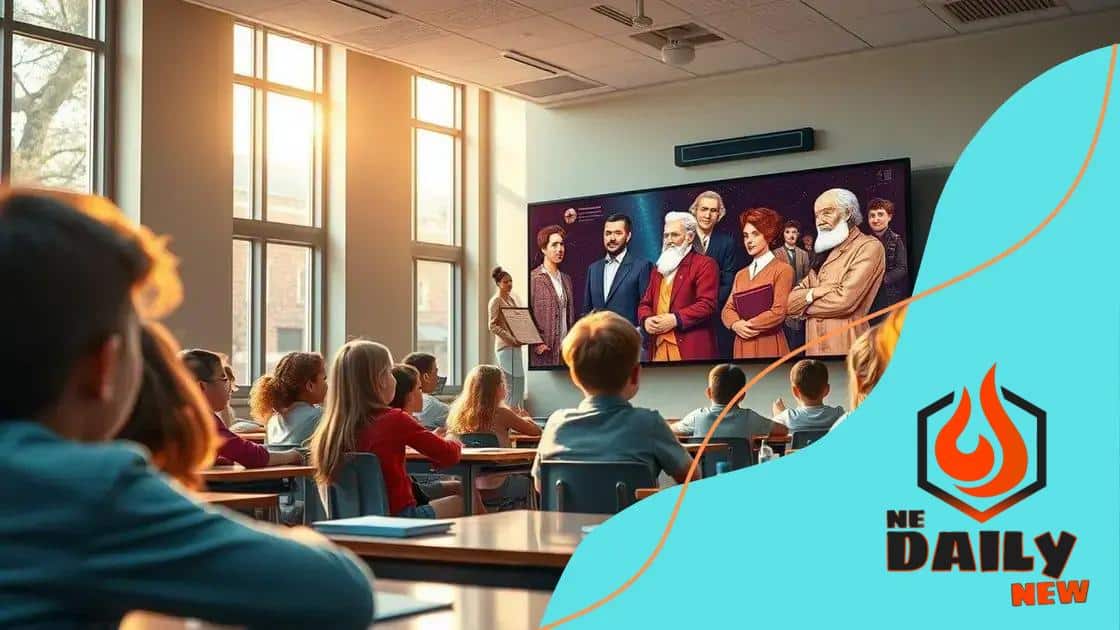How deepfake technology is being used for good

Deepfake technology is used for good by enhancing entertainment, improving educational experiences, and raising social awareness, while also presenting ethical challenges such as misinformation and consent issues.
How deepfake technology is being used for good might sound like a paradox, but this innovative tool is making waves in various productive fields. Ever wondered how it can enhance creativity and awareness? Let’s dive into the topic!
Understanding deepfake technology
Understanding deepfake technology is crucial as it becomes more prevalent in our digital landscape. This technology uses artificial intelligence to produce highly realistic fake videos and audio recordings. Its capabilities can be surprising, especially when we realize its potential to create content that looks genuine.
How Deepfake Works
At its core, deepfake technology employs machine learning algorithms to analyze and mimic human behavior, speech patterns, and facial movements. Artists and creators use these capabilities to produce entertaining and innovative media. However, knowledge of how it works can aid in discerning real content from fake.
Applications of Deepfake Technology
The potential of deepfake extends beyond entertainment, impacting various fields:
- Film and Television: Filmmakers use deepfake technology for special effects, including de-aging actors or reviving deceased stars.
- Education: Educators create interactive learning experiences with realistic simulations and historical reenactments.
- Marketing: Brands can personalize advertisements using customized videos to engage customers more effectively.
Despite its benefits, understanding the implications of this technology is important. Ethical concerns about misuse raise questions about trust and authenticity in digital communications.
The future of deepfake technology holds promise but requires awareness of its capabilities. Knowing how deepfakes work helps individuals and organizations navigate the evolving landscape of visual media, promoting responsible use and innovation.
Positive applications in entertainment
Positive applications in entertainment showcase the exciting potential of deepfake technology. This innovation has transformed how movies, television, and online content are created and consumed. Artists and filmmakers are utilizing deepfakes to push creative boundaries and offer unique experiences.
Enhanced Storytelling
Deepfake technology allows creators to enhance storytelling by introducing remarkable visual effects. Imagine a beloved actor appearing in a scene years after their passing, or creating historic figure cameos in modern films. These possibilities enrich narratives in unexpected ways.
Creative Transformations
Musicians and visual artists use deepfakes for transformative performances. For instance, a performer can collaborate with holograms of famous icons, creating immersive shows that transport audiences through different eras of music. This blending of past and present captivates fans and provides fresh content.
- Reviving Icons: Artists can resurrect legendary figures for performances.
- Fan Engagement: Creating personalized experiences for dedicated followers.
- Interactive Experiences: Engaging viewers through personalized storytelling.
Moreover, comedy shows use deepfakes to create humor by swapping faces or voices in unexpected contexts. These applications enhance entertainment value while provoking laughter and enjoyment. Viewers are often amazed by the seamless integration of these technologies, making content feel fresh and interactive.
Deepfake technology is not just a gimmick; it opens doors to creative experimentation. As developers and artists explore these possibilities, the entertainment industry continues to evolve, promising exciting advancements, all while raising questions about authenticity and originality.
Using deepfakes for education and awareness

Using deepfakes for education and awareness is an innovative approach that enhances learning experiences. This technology can create engaging educational content that captures attention and fosters understanding.
Enhancing Learning Experiences
Deepfakes can animate historical figures, making lessons come alive. Imagine a classroom where students can interact with a digital version of a famous scientist or a civic leader. This interactive element can spark curiosity and make information more relatable.
Building Empathy through Storytelling
Deepfakes are also utilized to create powerful narratives that promote social awareness and empathy. For example, educators can generate videos depicting the experiences of individuals from diverse backgrounds, allowing students to view history from multiple perspectives. This promotes a deeper understanding and appreciation of different cultures.
- Realistic Scenarios: Create simulations of real-life situations.
- Interactive History Lessons: Enable students to converse with historical figures.
- Social Awareness Campaigns: Raise awareness about social issues through compelling narratives.
Moreover, deepfake technology can support special education by providing personalized learning experiences. Students with different learning styles benefit from customized content that aligns with their needs. This tailored approach helps enhance their engagement and comprehension, making learning more effective.
As educators explore the potential of deepfakes, they strive to achieve a balance between innovation and ethics. Understanding the implications of this technology is essential to ensure responsible usage in educational contexts. By harnessing deepfakes for good, educators can transform conventional teaching methods into dynamic experiences.
Deepfakes in social initiatives and charities
Deepfakes in social initiatives and charities have emerged as a powerful tool to raise awareness and foster community engagement. This technology can be utilized creatively to support important causes and amplify messages that resonate with the public.
Raising Awareness
Nonprofits and social organizations use deepfakes to create compelling narratives that highlight social issues. By combining realism with creativity, these videos can capture attention and encourage discussions about critical topics, such as poverty, health care, and environmental concerns.
Engaging Storytelling
By generating lifelike representations of individuals affected by certain issues, organizations can foster empathy and understanding. For instance, deepfake technology can recreate personal stories from volunteers or beneficiaries, allowing viewers to connect emotionally with the cause.
- Effective Campaigns: Deepfakes can create powerful visuals to support fundraising campaigns.
- Interactive Content: Engaging audiences through simulated interactions with virtual advocates.
- Promoting Events: Deepfakes can enhance event promotions, showcasing exciting highlights and key speakers.
Additionally, charities have adopted deepfake technology for virtual reality experiences that immerse participants in the stories of those they are trying to help. This interactive approach encourages donations and fosters a sense of community, as people can see firsthand the impact their contributions can make.
Nevertheless, using this technology raises ethical questions. Organizations must ensure transparency when using deepfakes and avoid misleading representations. Balancing creativity with responsibility is essential for gaining public trust. Overall, when harnessed properly, deepfakes in social initiatives and charities can make a significant impact, driving positive changes in society.
Ethical considerations of deepfake technology
Ethical considerations of deepfake technology are critical as this tool grows in popularity and application. Understanding the potential risks and responsibilities involved can help ensure it is used effectively and ethically.
Potential for Misinformation
One of the biggest concerns surrounding deepfakes is their ability to create misleading content. Fake videos can spread quickly, leading to false narratives and damaging reputations. This raises questions about trust and the ability to discern real from fake media, requiring a greater emphasis on media literacy.
Consent and Privacy Issues
Another major ethical challenge is the issue of consent. Using someone’s likeness or voice without permission poses serious privacy concerns. Individuals must have agency over how their image is used. Laws and regulations will need to adapt as technology evolves to protect personal rights.
- Identity Theft: Deepfakes can be used to impersonate individuals, leading to potential identity theft.
- Reputation Damage: Fake content can harm an individual’s or organization’s reputation without recourse.
- Legal Implications: Legal frameworks may struggle to keep pace with advancements in deepfake technology.
There are also positive ethical dimensions. For instance, when used responsibly, deepfakes can promote empathy, awareness, and education regarding social issues. However, organizations must remain transparent about their use of this technology to build trust with their audiences.
The balance between innovation and responsibility is delicate. Engaging in thoughtful discussions about ethical implications will help guide the responsible use of deepfake technology. As the landscape of digital media changes, staying informed about these challenges is essential for everyone.
FAQ – Frequently Asked Questions about Deepfake Technology
What are deepfakes?
Deepfakes are realistic-looking fake videos or audio recordings created using artificial intelligence technology to mimic real people.
How can deepfakes be used positively?
Deepfakes can enhance entertainment, create engaging educational content, and raise awareness for social initiatives.
What are the ethical concerns surrounding deepfakes?
Ethical concerns include the potential for misinformation, lack of consent, privacy violations, and the risk of damaging reputations.
What should organizations do to use deepfakes responsibly?
Organizations should ensure transparency, obtain consent, and create guidelines to avoid misuse while exploring innovative applications.





